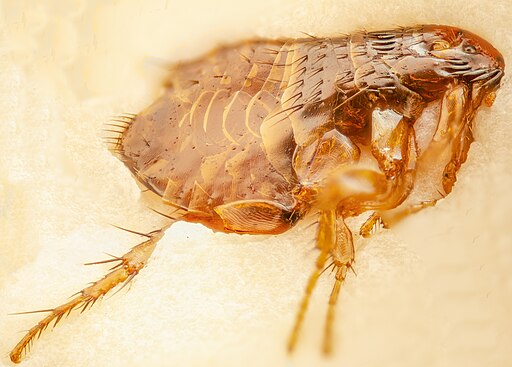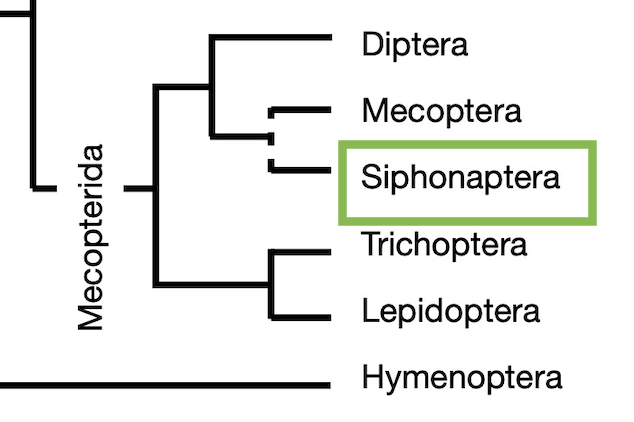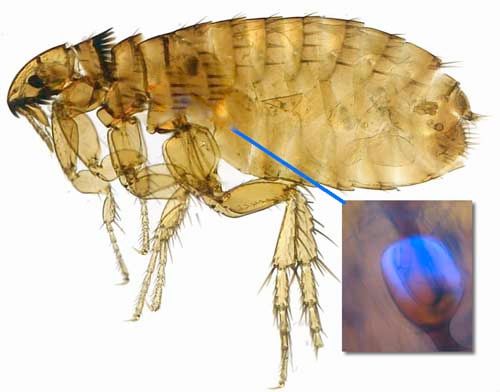38 Orders of Insects: Siphonaptera


Order Siphonaptera: Fleas
Siphonaptera
- common name: fleas
- from Greek: siphon = tube; aptera = wingless; refers to the tube-like mouthparts for blood sucking
- worldwide; about 2,500 species; greatest diversity in temperate zones
- adults are blood-sucking ectoparasites mostly on mammals but some on birds
- holometabolous; larvae free-living in nests of hosts; scavengers: consume organic debris
Characteristics of Siphonaptera
Adults
- Small (1-10mm), laterally compressed with backward pointing bristles on the body to aid with movement through fur or feathers
- Mouthparts haustellate: piercing and sucking; small antennae lying in grooves; simple eyes
- legs strong, terminating in strong claws for grasping host; hind legs adapted for jumping
Immatures
- immature stages (larvae) terrestrial, worm-like without legs (apodous), distinct head capsule
Life cycle
Eggs
- Laid on host but unattached; fall into nest.
- Eggs smooth, but with aeropyles – tiny holes in eggshell to allow gas exchange.
- Ovately rounded.
Larvae
- Feed on host-related debris on ground, usually in nest or lair.
- Primarily scavengers; blood excreted by adult fleas an essential part of larval diet in many species
Pupae
- Pupate in silken cocoon on ground; under high humidity may not spin cocoon
- Sometimes incorporate sand or other material into cocoon.
Adults
Ectoparasitic blood feeders: mostly on mammals, some on birds.
Detection of host differs in different species:
-
- visual (detect shadows)
- warmth
- carbon dioxide and odours
- vibrations
Transmission of Disease
Plague
Latin, plaga = a wound. Pl. plagues
Plague is a rodent-flea-rodent disease caused by the bacterium Yersinia pestis (formerly Pasturella pestis) – five forms
- bubonic plague
- pneumonic plague
- pestis minor
- septicemic plague
- andean plague
Plague is endemic to southern Asia but spread elsewhere in 165 AD, 542 AD, 14th century and 17th Century. It is primarily a disease of rodents and exists as sylvatic zoonosis in colonial burrowing rodents; bacteriaemia of rodents varies in degree and duration.
Plague killed 25% of human population in Europe during Middle Ages due to over-crowded and unsanitary urban conditions which led to an increased black rat (Rattus rattus) population. Plague is transmitted by the rat flea (and probably other fleas). The bacteria reproduce in the gut of the rat flea and cause a plug in the alimentary canal. The flea can’t successfully feed so regurgitates back into its host, spreading the pathogen to other hosts. Because the flea cannot feed, it grows hungrier and initiates more feeding attempts and movements between hosts, thus spreads plague very quickly.
Note:
Compared to their small size, fleas are capable of prodigious jumps. Not surprisingly scientists have been curious about how they manage to do this. Fleas have no wings and the metathorax is highly modified as it is associated with the large jumping legs. The energy for the jump is stored in the cuticle. Inside the thorax there is a system of cuticular ridges called the pleural arch. This structure has a pad of resilin that stores energy for the jump. The resilin pad is compressed by slow muscle action and a series of cuticular pegs and notches engage storing energy with the flea in a crouched position. A releaser muscle is activated and the stored energy is released, catapulting the insect into the air.

Topic Review
Do you know…?
- the main anatomical features of fleas
- The economical and medical importance of fleas
- The ways in which fleas are adapted for a parasitic lifestyle.
- Can you describe the life cycle of a flea.
- How do fleas detect the presence of a potential host?
- The role of fleas in the transmission of plague

